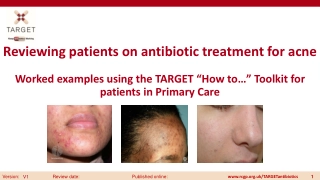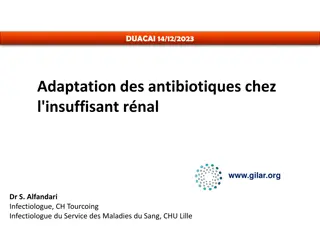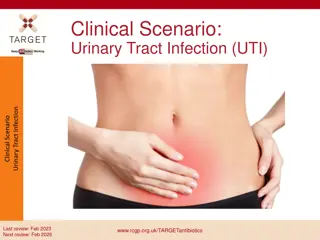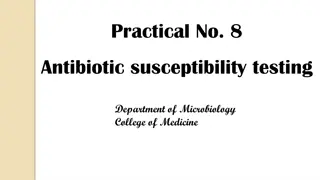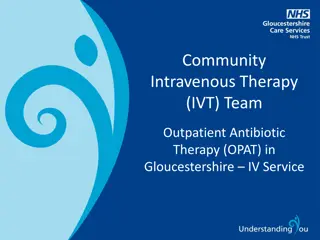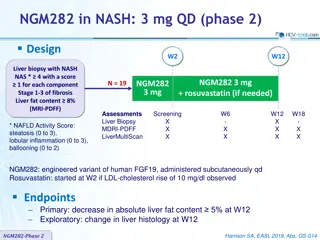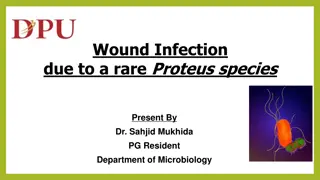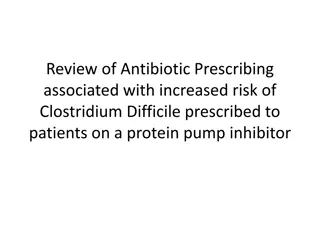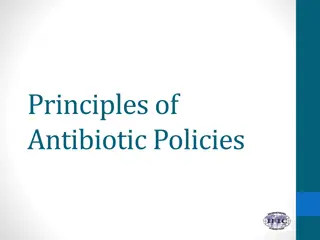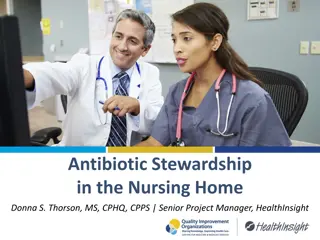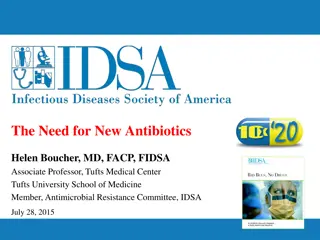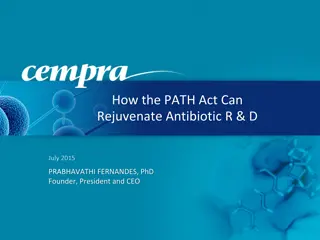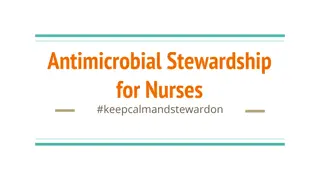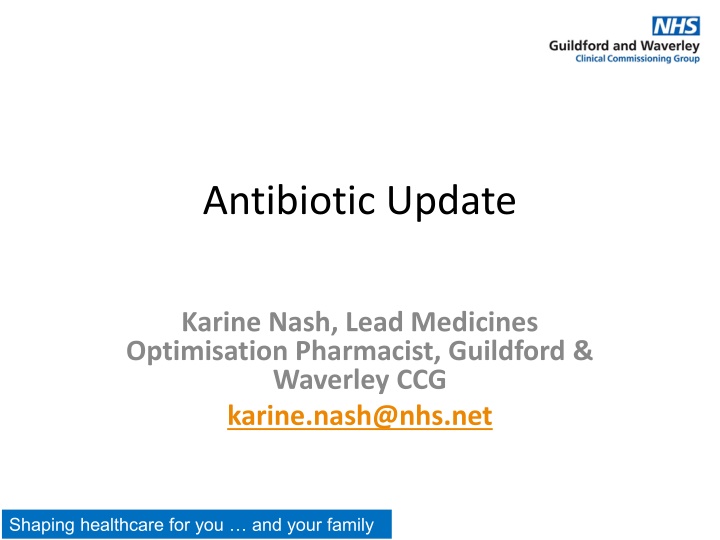
Antibiotic Update: National Measures and UTI Guidelines Explained
Explore the latest antibiotic update by Karine Nash, focusing on national measures for blood stream infections and the shift away from trimethoprim as the first-line treatment for UTIs. Learn why E.coli and UTIs, especially in the elderly, are a key concern, and discover the importance of nitrofurantoin in primary care. Stay informed on the quality premium measures and guidance for managing infections in primary care settings.
Download Presentation

Please find below an Image/Link to download the presentation.
The content on the website is provided AS IS for your information and personal use only. It may not be sold, licensed, or shared on other websites without obtaining consent from the author. If you encounter any issues during the download, it is possible that the publisher has removed the file from their server.
You are allowed to download the files provided on this website for personal or commercial use, subject to the condition that they are used lawfully. All files are the property of their respective owners.
The content on the website is provided AS IS for your information and personal use only. It may not be sold, licensed, or shared on other websites without obtaining consent from the author.
E N D
Presentation Transcript
Antibiotic Update Karine Nash, Lead Medicines Optimisation Pharmacist, Guildford & Waverley CCG karine.nash@nhs.net Shaping healthcare for you and your family
Antibiotic Update- Overview National Measures as part of the Quality Premium (QP)- focus on prescribing for UTI TARGET Toolkit Key primary care resource Management of Infection Guidance for Primary Care- latest information
National Measures: Quality Premium (QP) 17/18 measures for blood stream infections Part a) (i) in number of Gram negative blood stream infections (GNBSI) across the whole health economy (ii) Collection and reporting of a core primary care data set for E coli BSI Q2-4 2017-18 Part b)(i) in ratio of trimethoprim:nitrofurantoin (ii) in the number of trimethorpim items prescribed to patients aged 70 years or greater Part c) in number of antibiotics prescribed
QP: Why the focus on E.coli GNBSIs & UTI (particularly the elderly) ? Mandatory surveillance of E.coli has indicated an alarming rise in rates of E.coli bactaraemia (60.4 to 66.2 /100,000 population from 2012-15) Health Care Associated Infections (HCAIs) associated with multi-drug resistant (MDR) Gram Negative species such as E.coli are significant due to the limited number of effective antibiotics to manage them E.coli bacteraemia is the largest most prevalent group of GNBI Age group with the highest rates of E.coli bacteraemia in England are the elderly ( 75 years) . PHE have reported that 50% of cases relate to the urogenital tract of which 72% were patients > 65 years. In 2017.19 the focus will be patients 70 years. E.coli is the most common pathogen associated with UTI (approx 80 % of cases) On-going mandatory surveillance continues to identify previous UTIs as a key risk factor. Nitrofurantoin is now promoted 1st line for UTI in primary care for empiric management
Part b) (i) Ratio of trimethoprim:nitrofurantoin Prescribing data CCGs to July 2017
Why is trimethoprim no longer 1st line for UTI ? The ESPAUR report (2016) found that there is wide variation in the rates of resistance to trimethoprim (and other antibiotics) across England. In Gram-negative UTI, trimethoprim resistance ranges from 16.3% to 66.7% across CCGs. This may be related to variation in sending urine samples for laboratory testing. However, the report states that 86% of CCGs have resistance rates greater than 25%, highlighting that trimethoprim can no longer be advised as the first-line empiric antibiotic treatment for UTIs in England.
Nitrofurantoin Prescribing points Over the counter products (OTC) for cystitis: OTC products containing potassium or sodium citrate salts relieve symptoms by making the acidic urine (resulting from the bacterial infection) more alkaline. However, urine alkalisation reduces the effect of nitrofurantoin avoid concurrent use Long-term prophylaxis also consider for repeated treatment courses: monitor patients liver function ; pulmonary symptoms (consider measuring using spirometry) and renal function monitor RFTs, LFTs and pulmonary symptoms Nitrofurantoin only achieves antibiotic concentration in the urine with low circulating blood levels and poor tissue penetration making it unsuitable for the treatment of upper UTIs- do not use for upper urinary tract infection (UUTI) Poor Renal function: Nitrofurantoin is preferentially excreted into the lower urinary tract (approx 30-40%). If GFR < 30mls/min - therapeutic concentrations unlikely to be obtained and treatment failure likely- avoid if GFR < 30mls/min Pregnancy and lactation: Animal studies with nitrofurantoin have shown no teratogenic effects. However, it is contraindicated in infants < 3 months of age and in pregnant women during labour and delivery, due to possible risk of haemolysis of the infants' immature red cells. Breast feeding an infant known or suspected to have an erythrocyte enzyme deficiency (including G6PD deficiency), must be temporarily avoided, since nitrofurantoin is detected in trace amounts in breast milk- Avoid in pregnant women at term and avoid in breast feeding.
Other treatments for Lower UTI in Adults Pivmecillinam: A penicillin (mecillinam-type). Pivmecillinam is hydrolysed to mecillinam which is the active drug. Has significant activity against gram negative bacteria such as E.coli, klebsiella, enterobacter, and salmonellae. Not active against Ps.aeruginosa or enterococci. Fosfomycin: A phosphonic acid antibacterial, active against a range of gram-positive and negative bacteria including Staph aureus and Enterobacteriaceae. Previously only available as an imported unlicensed product (as 3g sachets). Since 2015 has been a licensed product available (under PI licence). There is now a fully licensed product available
TARGET Toolkit http://www.rcgp.org.uk/TARGETantibiotics Key set of resources for use by practitioners in primary care: includes leaflets to share with patients (such as Caring for children with coughs and Treating Your infection Leaflet- respiratory tract & UTI ); audit tools (including acute cough and UTI audit); antibiotic prescribing data (national/CCG level); and training resources (eg MARTI- Managing Acute Respiratory Tract Infections).
TARGET Toolkit: Treating Your Infection- UTI(for use in patient consultation)
Management of Infection Guidance for Primary Care- latest information The Public Health England template (formerly referred to as the HPA template) for the Management of Infection Guidance in Primary Care has been adopted without alterations for the following CCGs: Guildford & Waverley CCG, East Surrey CCG, Surrey Downs CCG, Crawley CCG, Horsham & Mid Sussex CCG & North West Surrey CCG. The following documents are available on the Prescribing Advisory Database (PAD) Web link to the PHE Management of infection Guidance for Primary Care 'Signposting Document' (last updated July 2017) To access these documents please refer to the Prescribing Advisory Database (PAD): http://pad.res360.net/ (search term: antibiotic , click on link to Guidelines-Antibiotic Guidelines ) As the PHE guidance has been adopted without alterations the guidance can also be accessed via Target Toolkit under the section National Antibiotic Management Guidance .
Antibiotic Awareness Campaigns World Antibiotic Awareness Week (WAAW) will be running from the 13th-19th November 2017.The theme for this year will be to Seek advice from a qualified healthcare professional before taking antibiotics : http://www.who.int/campaigns/world-antibiotic-awareness-week/en/ European Antibiotic Awareness day (EAAD) held annually on the 18th November: http://antibiotic.ecdc.europa.eu/en/eaad/antibiotics-info- prescribers/material-primary-care-prescribers/Pages/material-primary- care-prescribers.aspx Public Health England (PHE) in partnership with a number of organisations launched the Antibiotic Guardian campaign in 2014. This enables any healthcare professional or member of the public to make their own pledge on the use of antibiotics. For further information on how to make a pledge please visit the website: http://antibioticguardian.com/

